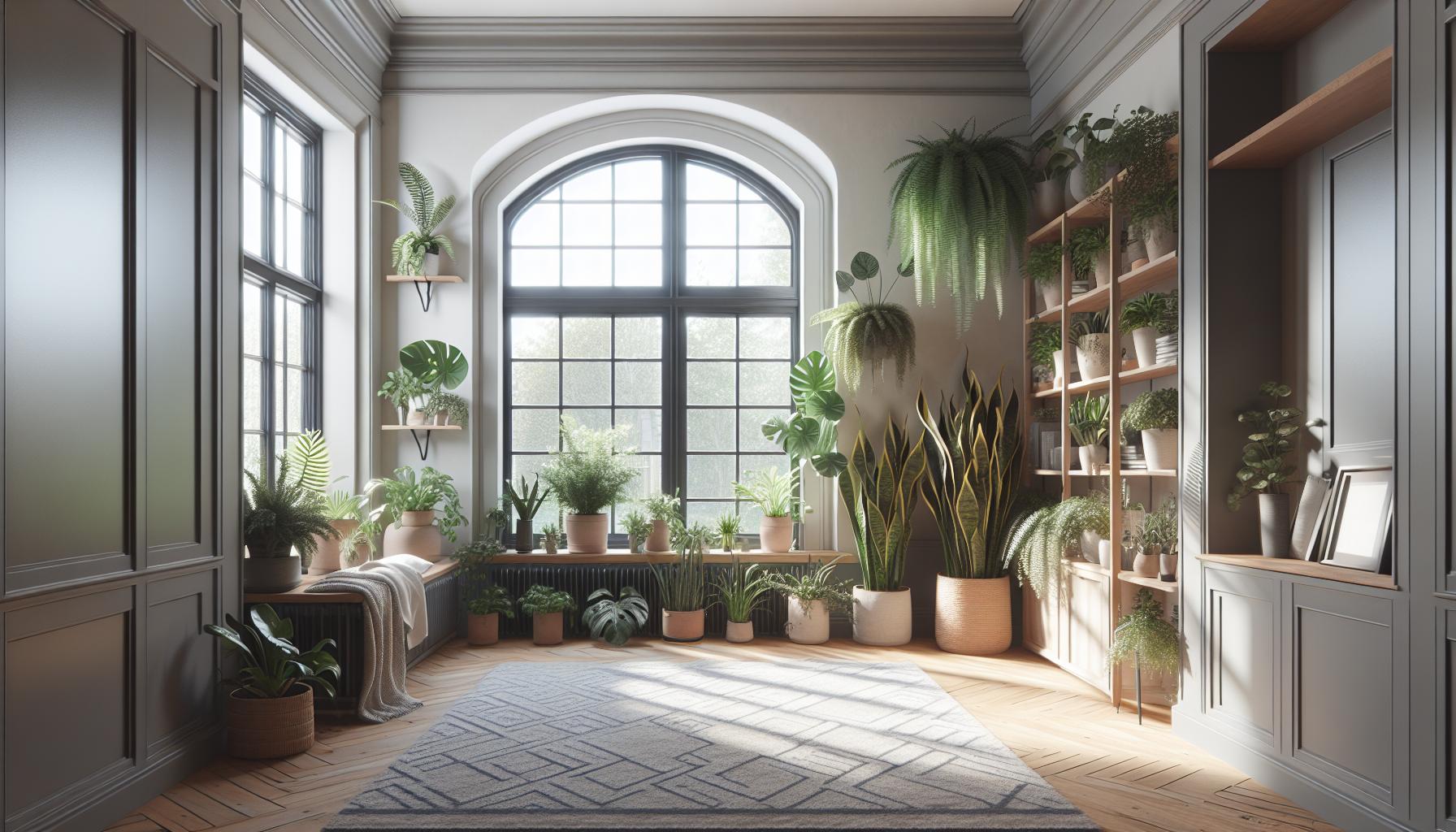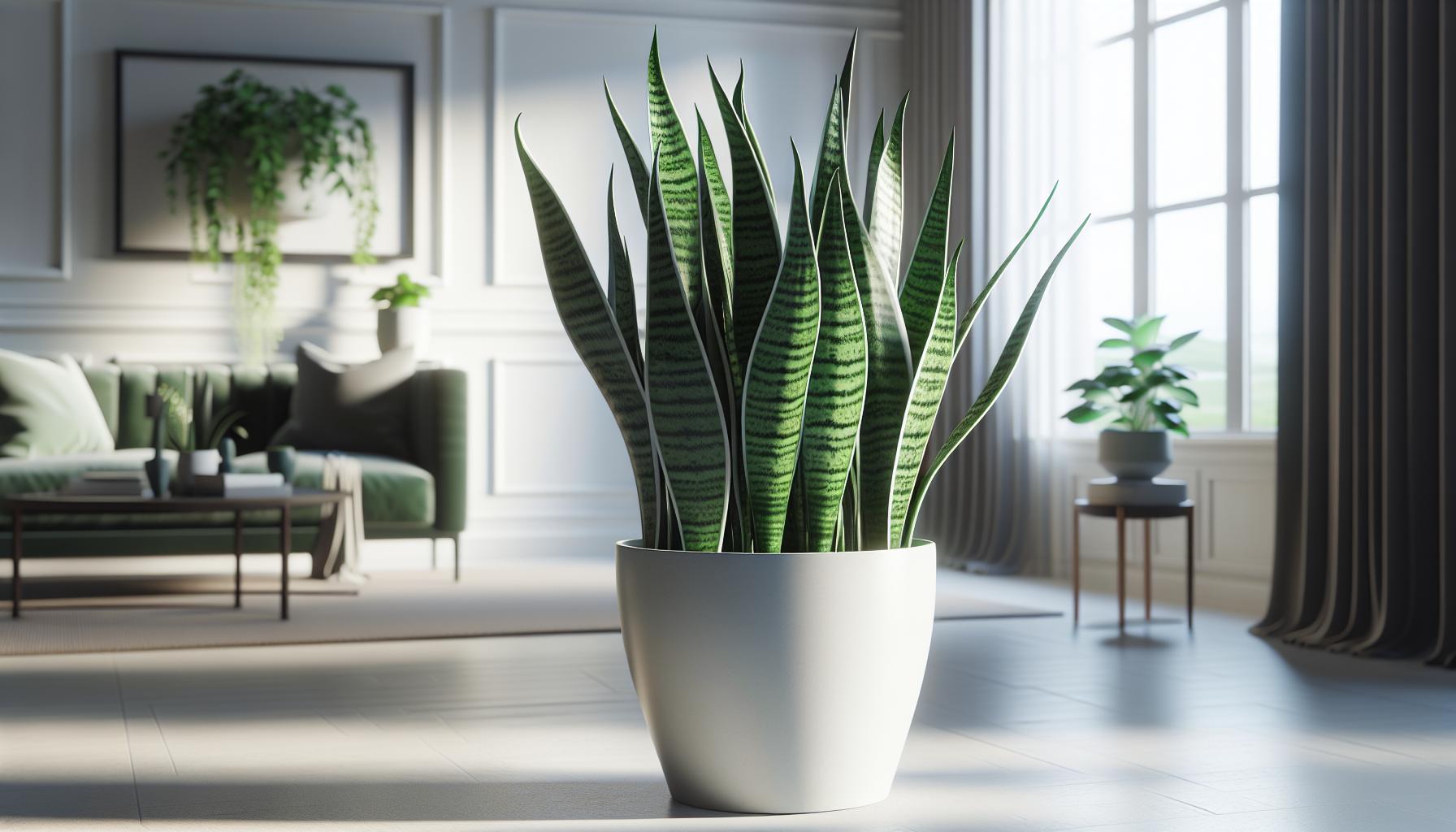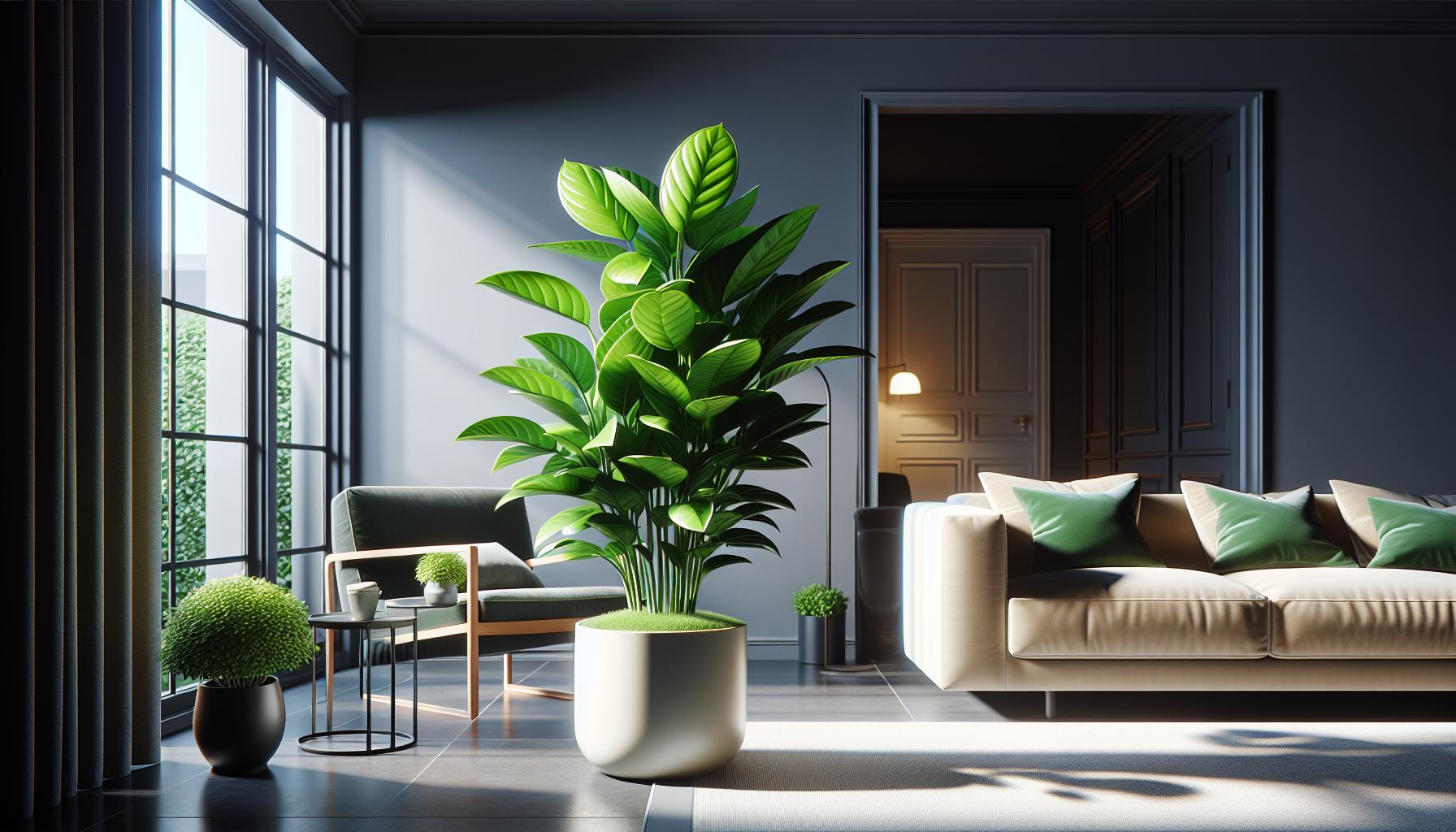As someone who’s been growing indoor plants for over a decade, I understand the challenge of finding the perfect greenery for those dark corners of your home. Not everyone has sun-drenched windowsills, but that doesn’t mean you can’t create your own indoor jungle.
I’ve discovered numerous resilient plants that thrive in low-light conditions, proving that you don’t need bright sunlight to maintain a lush indoor garden. Whether you’re living in a north-facing apartment or working in a dimly lit office, these shade-tolerant plants will bring life to your space without demanding much natural light in return.
Key Takeaways
- Snake Plant, ZZ Plant, Pothos, Peace Lily, Chinese Evergreen, and Philodendron are excellent choices for low-light indoor environments, requiring only 2-4 hours of indirect light daily.
- Low-light conditions measure between 50-250 foot candles (500-2,700 lux), with north-facing windows and areas 10-15 feet from windows being ideal spots for shade-tolerant plants.
- Most low-light plants require less frequent watering (every 2-3 weeks in winter, 7-10 days in summer) and well-draining soil with a mix of potting soil, perlite, and orchid bark.
- Optimal growing conditions include temperatures between 65-85°F (18-29°C) and humidity levels of 40-60% for most low-light tolerant plants.
- Common issues like yellow leaves (overwatering), brown leaf tips (low humidity), and leggy growth (insufficient light) help diagnose and address plant care problems.
Best Low-Light House Plants for Your Home
Snake Plant (Sansevieria)
The Snake Plant thrives in dark corners with minimal natural light. I’ve grown these sturdy plants in rooms with north-facing windows showing consistent growth patterns throughout the year. Their tall, architectural leaves filter indoor air pollutants like benzene toluene formaldehyde.
ZZ Plant (Zamioculcas zamiifolia)
ZZ Plants demonstrate exceptional tolerance to low-light conditions in my indoor garden. These glossy plants maintain their deep green color in spaces receiving as little as 2-3 hours of indirect light daily. Their thick rhizomes store water efficiently making them drought-resistant.
Chinese Evergreen (Aglaonema)
I’ve positioned Chinese Evergreens in various low-light spots throughout my home. These plants feature striking variegated leaves in silver green patterns continuing to produce new growth in spaces with minimal natural light exposure.
Pothos (Epipremnum aureum)
Pothos vines adapt remarkably to dim conditions while maintaining their trailing growth habit. I’ve successfully grown Golden Heart Lime Marble varieties in rooms with only fluorescent lighting displaying vibrant foliage year-round.
Peace Lily (Spathiphyllum)
Peace Lilies flourish under artificial light conditions in my office space. These elegant plants produce white bloom spathes even in low-light environments receiving 4-6 hours of filtered light daily.
Light Requirements Table:
| Plant Name | Minimum Daily Light | Ideal Temperature |
|---|---|---|
| Snake Plant | 2-3 hours | 60-85°F |
| ZZ Plant | 2-3 hours | 65-75°F |
| Chinese Evergreen | 3-4 hours | 65-80°F |
| Pothos | 3-4 hours | 60-80°F |
| Peace Lily | 4-6 hours | 65-80°F |
Cast Iron Plant (Aspidistra elatior)
The Cast Iron Plant earned its name through its ability to survive in deep shade. I’ve maintained these plants in basement areas receiving minimal ambient light maintaining their dark green foliage consistently.
Spider Plant (Chlorophytum comosum)
Spider Plants adapt to low-light settings while producing offspring plantlets. I’ve grown these air-purifying plants successfully under artificial lighting showing steady growth patterns over extended periods.
Understanding Low-Light Conditions

Low-light conditions in homes affect plant growth through specific measurable factors. I’ve identified key light measurements to help determine optimal plant placement in spaces with limited natural light.
What Qualifies as Low Light
Low light measures between 50-250 foot candles (500-2,700 lux) on a light meter. I categorize low-light areas into three distinct levels:
- Bright indirect light: 10-12 feet from north-facing windows
- Moderate low light: 15-20 feet from east or west-facing windows
- Deep shade: Areas receiving only ambient room light
| Light Level | Foot Candles | Lux | Example Location |
|---|---|---|---|
| Bright indirect | 150-250 | 1,600-2,700 | North window sill |
| Moderate low | 75-150 | 800-1,600 | 15ft from east window |
| Deep shade | 25-75 | 270-800 | Interior hallway |
Finding the Right Spots in Your Home
I evaluate potential plant locations using these practical methods:
- Shadow test: Cast shadows appear soft with fuzzy edges in low-light areas
- Paper test: White paper appears gray when held in the space
- Light meter readings: Taking measurements at different times throughout the day
- Cardinal direction check: North-facing windows provide consistent low light
- Distance mapping: Measuring feet from windows to determine light intensity zones
- North-facing windowsills
- East-facing windows with outdoor obstacles
- Interior walls 10-15 feet from windows
- Bathroom locations with frosted windows
- Office spaces with fluorescent lighting
Snake Plants: The Ultimate Shade-Tolerant Choice

Snake plants (Sansevieria trifasciata) rank among my most reliable low-light houseplants, thriving in dark corners where other plants struggle. I’ve grown these resilient plants in spaces receiving as little as 2-3 hours of indirect light daily.
- Watering: I water my snake plants every 2-3 weeks in winter, increasing to every 10-14 days during summer growth periods. The soil must dry out completely between waterings.
- Soil Mix: I use a well-draining potting mix with 50% regular potting soil, 25% perlite, and 25% coarse sand to prevent root rot.
- Temperature: These plants maintain optimal growth between 60-85°F (15-29°C), making them perfect for indoor environments.
- Fertilization: I apply a balanced 10-10-10 fertilizer once every 3 months during the growing season (spring through fall).
- Repotting: Snake plants need repotting every 2-3 years when roots become crowded.
| Care Aspect | Requirement |
|---|---|
| Light Level | 50-100 foot candles |
| Watering Frequency | Every 2-3 weeks |
| Optimal Temperature | 60-85°F (15-29°C) |
| Fertilizer Schedule | Every 3 months |
| Humidity Level | 30-50% |
ZZ Plants: Perfect for Dark Corners

ZZ Plants (Zamioculcas zamiifolia) thrive in low-light conditions, surviving with minimal natural light exposure of 2-4 hours daily. I’ve grown these sturdy plants in areas up to 10 feet away from windows, making them ideal for dimly lit spaces.
- Watering Schedule
- Water every 2-3 weeks in winter
- Extend to 3-4 weeks between waterings in summer
- Let soil dry completely between waterings
- Use the finger test: insert 2 inches into soil to check moisture
- Soil Requirements
- Plant in well-draining potting mix
- Add 30% perlite to standard potting soil
- Include orchid bark for additional drainage
- Maintain soil pH between 6.0-7.0
- Temperature & Humidity
- Grows in temperatures between 65-85°F (18-29°C)
- Tolerates normal household humidity (40-50%)
- Protect from cold drafts below 60°F (15°C)
- Keep away from air vents heat sources
| Growth Metrics | Measurements |
|---|---|
| Light Required | 2-4 hours daily |
| Mature Height | 2-3 feet |
| Growth Rate | 4-6 inches yearly |
| Watering Frequency | 2-4 weeks |
- Common Issues
- Yellow leaves indicate overwatering
- Brown leaf tips signal low humidity
- Leggy growth means insufficient light
- Black stems suggest root rot
- Maintenance Tasks
- Dust leaves monthly with damp cloth
- Remove dead foliage as needed
- Rotate pot quarterly for even growth
- Repot every 2-3 years when rootbound
Pothos: The Adaptable Classic
Pothos (Epipremnum aureum) thrives in low-light conditions, surviving with just 2-3 hours of indirect light daily. I’ve grown this versatile plant in various lighting conditions, from bright indirect light to deep shade, making it perfect for darker corners of any home.
Varieties and Growing Tips
The most common Pothos varieties adapt well to low light:
- Golden Pothos: Features yellow-green variegated leaves
- Marble Queen: Displays white-green marbled patterns
- Jade Pothos: Shows solid green foliage
- Neon Pothos: Exhibits bright chartreuse leaves
Growing requirements for optimal care:
| Care Element | Specification |
|---|---|
| Water Frequency | Every 7-10 days in summer, 10-14 days in winter |
| Soil Type | Well-draining potting mix |
| Temperature Range | 60-80°F (15-27°C) |
| Humidity | 50-70% |
| Fertilization | Monthly during growing season |
Key growing tips:
- Allow soil to dry between waterings
- Prune vines at 12-inch intervals to promote bushier growth
- Wipe leaves monthly to remove dust
- Rotate pot quarterly for even growth
- Check roots every 18-24 months for repotting needs
Support options for climbing:
- Moss poles
- Bamboo stakes
- Wall trellises
- Tension wires
- Yellow leaves: Overwatering
- Brown edges: Low humidity
- Leggy growth: Insufficient light
- Small leaves: Nutrient deficiency
Chinese Evergreen: A Low-Maintenance Beauty
Chinese Evergreen (Aglaonema) creates vibrant displays in dim spaces with only 2-3 hours of indirect light daily. I’ve grown multiple varieties of this plant, including Silver Bay, Red Siam Maria, and Emerald Beauty, each adapting perfectly to low-light conditions.
Light Requirements
Chinese Evergreen thrives in:
- North-facing windows with filtered light
- Interior rooms with fluorescent lighting
- Areas 6-8 feet away from bright windows
- Spaces with 50-200 foot candles of light
Water & Soil Needs
The plant requires specific care parameters:
| Care Aspect | Winter | Summer |
|---|---|---|
| Watering Frequency | Every 2-3 weeks | Every 7-10 days |
| Soil Moisture | Top 2 inches dry | Top inch dry |
| Humidity Level | 40-50% | 50-60% |
I use a well-draining potting mix combining:
- 50% regular potting soil
- 25% perlite
- 25% orchid bark
Temperature & Growth
Chinese Evergreen maintains optimal growth at:
- 65-80°F (18-27°C) during day
- Minimum 60°F (16°C) at night
- Away from cold drafts or AC vents
Common Issues
I monitor these signs for potential problems:
- Yellow leaves indicate overwatering
- Brown leaf tips signal low humidity
- Pale foliage suggests excessive light
- Leggy growth means insufficient light
The plant grows 12-24 inches tall with proper care, displaying variegated leaves in patterns of green, silver, pink or red depending on variety.
Peace Lily: Thriving in the Shadows
Peace Lilies (Spathiphyllum) adapt exceptionally to low-light environments, growing successfully with just 3-4 hours of indirect light daily. I’ve discovered these plants produce their signature white blooms even under fluorescent lighting, making them perfect for offices or bathrooms.
Light Requirements
- Place 6-8 feet away from north-facing windows
- Tolerate fluorescent light in windowless rooms
- Show leaf burn in direct sunlight exposure
- Indicate light deficiency through decreased blooming
Watering & Care Guidelines
| Care Aspect | Winter | Summer |
|---|---|---|
| Watering Frequency | Every 10-14 days | Every 5-7 days |
| Soil Moisture | Top 2 inches dry | Top inch dry |
| Temperature Range | 65-75°F (18-24°C) | 70-85°F (21-29°C) |
Growth Characteristics
- Reaches heights of 1-3 feet indoors
- Produces glossy dark green leaves
- Develops white spathe flowers
- Spreads 1-2 feet wide at maturity
Maintenance Tips
- Remove yellow leaves at the base
- Wipe leaves monthly with damp cloth
- Divide crowded plants every 2-3 years
- Mist twice weekly to maintain humidity
- Feed with balanced fertilizer quarterly
- Brown leaf tips indicate low humidity
- Yellow leaves signal overwatering
- Drooping foliage means water needed
- Lack of flowers suggests insufficient light
- Black leaves show cold damage exposure
Philodendron: The Reliable Indoor Favorite
Philodendrons adapt exceptionally to low-light conditions, requiring only 2-3 hours of indirect light daily. I’ve grown multiple varieties of Philodendrons, including Heartleaf, Brasil Philodendron, Birkin for over 5 years, observing their resilient growth patterns in shadowy corners.
Light Requirements
- Place 3-6 feet away from north-facing windows
- Position near east-facing windows with filtered light
- Grow under fluorescent lights at 6-12 inches distance
- Rotate the pot 45 degrees weekly for even growth
Varieties for Low Light
- Heartleaf (Philodendron hederaceum)
- Brasil Philodendron (Philodendron hederaceum ‘Brasil’)
- Birkin (Philodendron ‘Birkin’)
- Philodendron Prince of Orange
- Silver Sword Philodendron
Care Requirements Table
| Care Aspect | Winter | Summer |
|---|---|---|
| Watering Frequency | Every 2-3 weeks | Every 7-10 days |
| Temperature Range | 65-75°F (18-24°C) | 70-85°F (21-29°C) |
| Humidity Level | 40-50% | 50-60% |
| Fertilization | None | Every 4-6 weeks |
- Dark green leaves indicate optimal light exposure
- Pale leaves signal too much light
- Leggy stems suggest insufficient light
- Yellow leaves point to overwatering
- Brown leaf tips indicate low humidity
My experience shows Philodendrons thrive in a well-draining potting mix with 60% peat moss 30% perlite 10% orchid bark. These plants develop aerial roots for climbing support structures in their natural habitat establishing themselves in low-light environments.
Caring for Low-Light Plants
I’ve developed specific care techniques for low-light plants over years of indoor gardening experience. These methods focus on maintaining plant health while compensating for reduced light conditions.
Watering Guidelines
Low-light plants require less frequent watering than their sun-loving counterparts. Here’s my tested watering approach:
- Check soil moisture by inserting a finger 1-2 inches deep before watering
- Water thoroughly until it drains from bottom holes when soil feels dry
- Reduce watering frequency by 25-30% compared to the same plant in brighter light
- Maintain a consistent watering schedule based on seasonal changes:
- Summer: Water every 7-10 days
- Winter: Water every 14-21 days
| Plant Type | Summer Watering | Winter Watering |
|---|---|---|
| Snake Plant | Every 10-14 days | Every 21-28 days |
| ZZ Plant | Every 14-21 days | Every 28-35 days |
| Pothos | Every 7-10 days | Every 14-21 days |
| Peace Lily | Every 5-7 days | Every 10-14 days |
- Leaf Problems
- Yellow leaves indicate overwatering
- Brown leaf tips signal low humidity
- Pale leaves suggest insufficient light
- Growth Issues
- Leggy stems from reaching for light
- Slow or stunted growth during winter months
- Reduced leaf size in extremely low light
- Root Concerns
- Root rot from overwatering
- Delayed root development in cool temperatures
- Compacted soil from improper drainage
- Environmental Stress
- Leaf drop from cold drafts
- Dust accumulation on leaves
- Fungal growth in consistently wet soil
Conclusion
Growing plants in low-light conditions doesn’t mean sacrificing the joy of indoor gardening. I’ve discovered through years of experience that these resilient plants can transform dark corners into lush green spaces with minimal effort.
Whether you choose a tough Snake Plant a low-maintenance ZZ Plant or an adaptable Pothos you’ll find that these plants are perfect companions for any home. I’ve seen them thrive in offices bathrooms and even windowless rooms.
Remember that “low light” doesn’t mean “no light” and each plant has its unique needs. With proper care and attention to watering schedules these shade-tolerant plants will reward you with healthy growth and improved indoor air quality. Now you’re ready to create your own thriving indoor garden regardless of your lighting situation.




